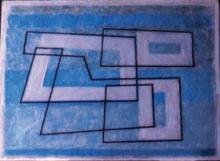Anni and Josef Albers
dal 13/11/2006 al 11/2/2007
Segnalato da
Museo Nacional Centro de Arte Reina Sofia
13/11/2006
Anni and Josef Albers
Museo Nacional Centro de Arte Reina Sofia, Madrid
Latin American Journeys

Latin American Journeys
Anni and Josef Albers made more than fourteen journeys to Latin America between 1934 and 1967, visiting Cuba, Mexico, Peru and Chile. They came to appreciate and value highly the culture of these countries, their landscapes, their people, and their art. The works in this exhibition tell the story of Anni and Josef Albers’s enduring love of Latin America and the way that their travels sustained and transformed their art and their lives.
Anni Albers eloquently expressed her awe and love for the art of Mexico and Latin America I n her writings:
As our interest in and our love for the art of pre-Conquest Mexico grew, we ventured into regions not yet then included in the regular tourist itinerary … we went along high cactus fences in village streets silent and empty … we sat in fields, sandwiches in hand, and wherever we looked, ancient pottery shards protruded … we were aware of layer upon layer of former civilization … waiting for excavation … pre-Conquest art had not yet found acceptance as an art, and we felt the excitement of discovery … we visited pyramids … that left us in awe of the great concepts of their architecture. [Art] has a restorative power that we need again and again. Perhaps it was this timeless quality in pre-Columbian art that first spoke to us, regardless of the significance it must have had to a contemporary community.
Anni Albers, November 1969
Along with cave paintings, threads were among the earliest transmitters of meaning. In Peru, where no written language … had developed even by the time of the Conquest … we find—not in spite of this but because of it—one of the highest textile cultures we have come to know. … Much of the potency of textile art had been lost during centuries of efforts to produce woven versions of paintings …Works of art, to my mind, are the ancient Peruvian pieces, preserved by an arid climate and excavated after hundreds and even thousands of years. …Their personages, animals, plants, stepforms, zigzags … are all conceived within the weaver’s idiom. …Of infinite phantasy within the world of threads, conveying strength or playfulness, mystery or the reality of their surroundings, endlessly varied in presentation and construction, even though bound to a code of basic concepts, these textiles set a standard of achievement that is unsurpassed.
Anni Albers, from On Weaving, 1965
The first stimulus to make jewelry from hardware came to us from the treasure of Monte Alba'n … of such surprising beauty in unusual combinations of materials that we became aware of the strange limitations in materials commonly used for jewels … we discovered the beauty of washers and bobby pins … enchanted we stood before kitchen sink stoppers … the art of Monte Alba'n had given us the freedom to see things detached from their use, as pure materials, worth being turned into precious objects.
Anni Albers, On Jewelry, 1942
After a lifetime of work weaving by hand and designing textiles, Anni Albers began to experiment with printmaking in the 1960s. Substituting the grids of pre-printed graph paper for the warp and weft of the loom she created a series of drawings on which the prints would be based.
Between 1936 and 1946 Josef Albers’s paintings went through a series of transformations. Breakthroughs and shifts coincided with extended stays in Mexico, where he could paint undisturbed for long periods. By 1940 Albers was moving toward pure color in paintings like Growing and To Mitla which recalls the deep red painted walls surrounding the Palace of the Columns at Mitla, Oaxaca. These works and To Oaxaca of 1943 prefigure the series of Variants, also called Adobes, which he would begin in late 1946. He wrote to a friend:
Since January [I have painted] only one theme in about 70 studies. What interests me most now is how colors change one another according to the proportions and quantities … I’m especially proud when colors lose their identity and become unrecognizable. Greens become blue, neutral grays become red-violet and so on. Dark colors become light and vice versa. And what is amazing about all this is that I use colors exactly as they come out of the tube. I mix only pink and purple which don’t exist in the tube. … It’s an extremely restricted and certainly very one-sided method of working. But terribly exciting. Opaque colors appear transparent only as a result of the way they are combined. Light [colors] heavy and the other way round, shiny [colors] matt.
Josef Albers, September 1947
With his portable 35 mm camera, Josef Albers took thousands of photographs of the pre-Hispanic sites in Mexico and Peru. He used the contact prints and their photographic enlargements as the basis for photocollages that were more than simple travel mementoes. They were tools by which Josef analyzed and reconstructed the archaeological sites and they served as a kind of sketchbook or a sourcebook of three-dimensional structures, volumes, and patterns. They represent one vital step in Albers’s process of distilling Mesoamerican architectural forms into spare, geometric motifs.
Curator: Brenda Danilowitz y Marta Gonza'lez
Coordination: Bele'n Di'az de Ra'bago
Museo Nacional Centro de Arte Reina Sofia
Santa Isabel, 52 - Madrid



